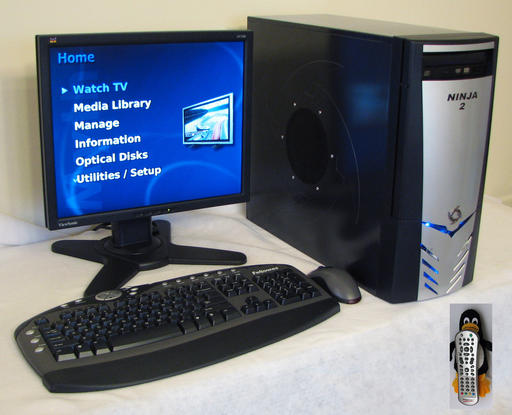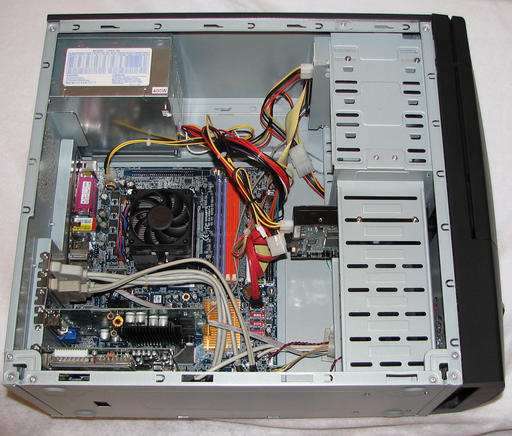

The Ultimate Multimedia Center actually slides in under a million dollars.
Venice Beach is one of my favorite beaches in the world, and when I go to the Los Angeles area, I try to visit the beach, just to stroll along the sidewalk and watch the people. One of the people I like to watch for is my friend Clay Claiborne who owns Cosmos Engineering, and who named his Web site Linux Beach.
Clay is a Linux advocate from way back, and on my last trip out there, he was bragging about the multimedia system he had built for his house using Linux to control it. When I heard about the Ultimate Linux System issue coming up, I put Clay to the challenge.
Now, the first thing a person has to understand is that there is no upper limit for what you can spend on multimedia equipment, and that of course also means the computer system you can buy to capture, edit and play back the multimedia. If I wanted to buy an “ultimate” system, I would simply set aside a million dollars or so and go from there. So, the first place we started with was what a person who had a great love for multimedia, but an average-sized wallet would want in a system. I am sure we will get lots of letters complaining that our system was not “ultimate” enough, but I hope those letters will be outweighed by the ones that say, “Gee, I can almost afford that, and it is really cool—it all works together and it was easy to install.”
Along those same lines, Clay designed two systems. Each one is expandable, but one is a bit less expensive than the other, for those with smaller wallets. Clay has pledged to supply us with all the specs and the software he uses on them so people can build them from scratch. For those with more money than time, Clay will be happy to order, assemble, install the software, test and ship them to you, and you may well be happy to buy the service. Your choice.
In honor of his love for the seaside, Clay has named these systems the Linux Beach MultiMedia Center 500 (LBMC 500) and the Linux Beach MultiMedia Center 1000 (LBMC 1000).

Figure 1. Linux Beach MultiMedia Center with optional monitor, keyboard and mouse—Tux is not available.

Figure 2. The internals of the Linux Beach MultiMedia Center 500; motherboard is the same as the LBMC 1000.
First, both systems come with a remote control (who wants to get off the couch?), and both systems are designed to be whisper quiet through the use of specialized cases, careful attention to power supply selection and selection of graphics cards that have no extra fan.
The smaller LBMC 500 system uses the Ninja 2 case, which was designed with low noise in mind. Although it does have a door on the front [I hate doors—md] you can get to the DVD without opening it. There are also two USB ports, one FireWire port and a set of headphone and mic jacks on the front for easy access. The power supply is 400W—more than adequate for the smaller system.
The larger LMBC 1000 is built around the Antec Sonata II case, which also was designed for quiet operation. It uses a SmartPower 2.0 450-Watt power supply that is “smart enough to turn its fan off when it is not needed”, as Clay puts it. Following along the lines of “quiet”, the CPU fan is also RPM-controlled for low noise levels. Clay says he added blue LEDs to the front of the case so you will know it is turned on. Unfortunately, with this case, you have to open the front door to get to your DVD drive, but the extra noise muffling makes that reasonable.
At my urging, Clay also chose as an alternative to the Antec Sonata II, the Antec Overture II Quiet Media case for those people who like their media centers to be horizontal instead of vertical. But please remember not to block the ventilation holes with “stuff”. Both the vertical and horizontal cases have two USB ports, one FireWire and audio ports on the front.
Both systems use the same motherboard, the Gigabyte GA-K8NF-9. The smaller system gives you an 800Mbps FireWire port along with its eight USB 2.0 ports. In order not to use those high-speed ports for anything other than high-powered storage, the motherboard also gives you S/PDIF Digital Audio In and Out to drive your surround sound 5.1 or 7.1 audio system, as well as eight channels out to drive analog amplifiers directly. It also gives you a parallel printer port and one RS-232 com port for those legacy peripherals, as well as PS/2 ports for mouse and keyboard. Video out is supplied by standard analog VGA, digital DVI or S-Video for the TV. Two monitors or a monitor and a TV can be used for different signals at the same time. The TV is properly set up with over scan so that everything appears as it should. Video can be captured with the TV tuner, composite or S-Video in. Finally, Gigabit LAN gives you the tightest possible connection to the world.
The larger system gives you the same features, but three 800Mbps FireWire ports, ten USB 2.0 ports and two RS-232 com ports.
Both motherboards also use the NVIDIA nForce4 chipset on the mainboard to provide the best PCI timing and drive a 3Gb/s SATA bus, two PCI and two PCI-Ex1 slots for expansion. The NVIDIA GeForce video output is driven at twice the speed of an AGP 8X through the PCI-EUR-Express 16 port.
The CPU is the next place that the two systems differ. Although both use a 64-bit AMD processor with an 800MHz memory bus speed and 4GB memory maximum, the larger system uses a dual-core chip, effectively giving you about twice the CPU power, although either chip is honking at the speeds they are going. And although the larger system comes with 1GB of memory standard, the smaller one comes with “only” 512MB. [maddog remembers when he paid $23,000 US for 1MB of semiconductor memory and $128,000 for 64 Kilobytes of Core—he will tell you some time what “Core” is.]
Both systems offer you an upgrade of both CPU and memory to your wallet's capacity. The CPUs offered for the LBMC-500 are the AMD Athlon 64 3200+ (optional) or the 3700+ or 4000+ as options. For the LBMC-1000, the CPUs are the AMD Athlon 64 2X 4200+ (standard), or the optional upgrade to the 4600+.
Speaking of capacity, the smaller system comes with a MAXTOR 250GB, 7200 RPM SATA drive with 16MB of cache, but it can be ordered with two of these drives in the system for a bit more money. The larger system comes with a MAXTOR drive that is 400GB standard, and a second drive could be added. Both systems sport a Sony double layer (16x) DVD rewritable optical disk drive that can hold up to 8.5GB on a disk. The Sony's CD-R write speed is 48x.
For those of you who are really starved for storage, the 800Mbps FireWire will give you amazing storage capacities outside the main CPU cabinet.
The TV tuner card in each system is the Hauppauge WinTV PVR150. Don't be turned off by the WinTV part, it is nicely supported by Linux. You also can get the pcHDTV HD3000 as an additional upgrade on both systems. With this second tuner, you get to watch and record high-definition TV, and also record one program while watching another, or record two TV programs at once. Clay tells me that on the larger system you can install enough tuners to record six TV channels at one time. But Clay, I have other things to do with my life than watch TV—like listen to music!
TiVo changed my life. I never watched much TV at all in my adult years, but I was very loyal to the shows I watched. TiVo allowed me to watch what I wanted, when I wanted. A couple of problems though—it was available only in the US, and although it was running Linux, it had big “do not open this box” labels on it. Of course, intrepid Linux hackers ignored this warning, and soon TiVos had much larger storage capacities and remote setup and so on.
Clay calls the software MythTV “TiVo on steroids”, and although Linux Journal does not condone drug usage of any type, I have to agree.
The core software of this system is Ubuntu. Clay chose Ubuntu because it gave good basic support to the multimedia, and because he likes their slogan, “I am what I am because of who we all are”. I have to admit that I like that slogan too.
Clay installs all of the core Ubuntu to make it easily available to the end user to tailor. So, you could run your Web server off your multimedia center. You also could use your multimedia center to handle your e-mail. Your choice.
On the other hand, you could use it just to record the TV shows that you want to watch and then play them back again using the MythTV software that Clay integrates. Or, use MPlayer to play your DVDs and other audio/video files in a huge number of formats. Or use XMMS to play back music, create playlists or create visual aids to go with your music.
And, of course, the remote is supported by MythTV, MPlayer and XMMS.
Clay also mentions that although all of the day-to-day audio/video functions can be controlled by this remote, you may want to get a wireless keyboard and mouse to operate the system better.
For complete specs, ordering information, copies of the software, and other things associated with this project, please go to CosmosEng.com/cgi-bin/cosmoseng/004-LBMS2.html for the Linux Beach MultiMedia 500 and CosmosEng.com/cgi-bin/cosmoseng/004-LBMS1.html for the Linux Beach Multimedia Center 1000.
And, for your own sake, get off the couch every once in a while—maybe to get a soda from the fridge.
TiVo is a trademark of TiVo, Inc. Linux is a trademark of Linus Torvalds.